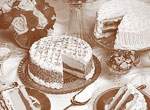 Cakes are basically made from fat, flour, sugar and eggs, with the exception of the sponge, which is fatless. The texture varies according to the method of preparation and the proportion of fat to flour. The richest cakes include equal proportions of the basic ingredients as in a Victoria Sandwich Cake, but additions can be made such as dried fruit nuts and spices as for a Christmas or Birthday Cake. Numerous flavourings can be included and these vary from chocolate and coffee to coconut, orange or lemon etc.
Cakes are basically made from fat, flour, sugar and eggs, with the exception of the sponge, which is fatless. The texture varies according to the method of preparation and the proportion of fat to flour. The richest cakes include equal proportions of the basic ingredients as in a Victoria Sandwich Cake, but additions can be made such as dried fruit nuts and spices as for a Christmas or Birthday Cake. Numerous flavourings can be included and these vary from chocolate and coffee to coconut, orange or lemon etc.
The All-in-One Method
This is a quick and easy way of preparing all types of cakes other than the fatless sponge.
All the ingredients are beaten together with a wooden spoon and air is incorporated into the mixture to form air cells which are stabilised by the sugar. The soft blend of Stork enables air to be incorporated easily and it also mixes readily with the other ingredients. Additional raising agent is required however, as not quite enough air is introduced during the initial mixing. During baking, the fat melts, releasing the air cells in the flour and liquid mixture. The raising agent in the flour reacts with the liquid from the egg to produce carbon dioxide and steam. As pressure builds up inside the cake these gases move to the air cells formed during mixing and cause the cake to rise. At the end of baking, this movement ceases as the proteins in the flour and eggs set. The cooked cake consists of a large number of air cells surrounded by a network of proteins in which the starch granules are held.
The texture of a Sandwich Cake made by this method is fairly open.
The Creaming Method
This is the traditional method of cake making.
The Stork and sugar are beaten together with a wooden spoon until the mixture is light in colour, fluffy in texture and the sugar has dissolved. A large number of air cells are produced which are stabilised by the sugar. More air cells are introduced by beating the eggs into the fat and sugar mixture. It is unlikely that any additional air will be incorporated by sieving or folding in the flour, but it must be folded in gently so that no air is lost.
During baking the cake rises for the same reasons as the All-in-One cake. The texture of a creamed cake is a little closer and finer than an All-in-One Cake.
The Rubbing-in Method
This method is not widely used today and only cakes including half or less than half fat to flour are prepared this way. The Stork is cut into fairly small pieces and rubbed lightly into the flour with the fingertips and thumbs. At the same time the mixture should be lifted well above the bowl to help incorporate air into the cake. When ready to add the other dry ingredients and liquid, the mixture should resemble fine breadcrumbs. The texture of a rubbed-in cake is fairly open.
The Melting Method
This is a very easy method of preparing cakes as a minimum amount of handling is required. It is the traditional method for preparing Gingerbread, but Fruit Cakes can be made this way as well.
The Stork, sugar, syrup, liquid and fruit (if used) are heated gently until the Stork has melted. This mixture is cooled and added to the dry ingredients and then beaten together with the egg until well mixed.
The texture of Gingerbread is fairly open and that of a Fruit Cake fairly crumbly but both are moist.
The Whisking Method
This is the method used for preparing Fatless Sponges. Swiss Rolls and also Genoese Sponges.
The eggs and sugar are whisked together for 10-15 minutes over hot water to dissolve the sugar completely and then for a further 5 minutes off the heat to cool the mixture. A great deal of air is incorporated into the mixture at this stage to give the cake its light, spongy texture. Finally, the flour is folded in carefully so that the incorporated air is not lost.
N.B: If using an electric mixer the whisking time is reduced to 5-10 minutes and it is not necessary to whisk over hot water. The texture of a fatless sponge is even, light and very soft. It dries out very quickly so should be eaten within 2 days of baking.
Temperature
Cakes are best made in a warm kitchen with ingredients at a temperature not lower than 65-70°F (20-21 °C). If, therefore, the ingredients and equipment are stored in a cool place, they should be put ready for use at least two hours before preparing the cake. This will also make preparation much easier. The only exception is when the rubbing-in method is used.
Oven
Turn on the oven heat 15 minutes before needed, setting at the stated temperature for the recipe, then when the cake goes in, the all-over heat inside will have reached the correct temperature. Remember, ovens vary, so the instructions given in recipes for gas and electricity settings may have to be varied for individual cookers. Check the position of shelves.

